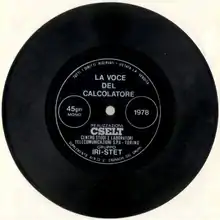
Multichannel Speaking Automaton (MUSA) was an early prototype of Speech Synthesis machine started in 1975.
Description
It consisted of a stand-alone computer hardware and a specialized software that implemented a diphone-synthesis technology. It was one of the first real-time TTS systems. It was able to read Italian in intellegibile robotic voice and also to sing managing up to 8 synthesis channels in parallel thanks to Linear predictive coding technology.[1] In 1978 it was released, after the building of a working prototype,[2] a 45" rpm audio disk containing some trial content of such synthesis, including the song "Fra Martino Campanaro" in "a cappella" (multiple voices) style, attached to some commercial reviews.[3] The experiment was conducted by CSELT, Turin, Italy and was led by Giulio Modena.[4]
See also
Notes
- ↑ Nebbia, Luciano; Lucchini, Paolo (April 1979). "Eight-channel digital speech synthesizer based on LPC techniques". ICASSP '79. IEEE International Conference on Acoustics, Speech, and Signal Processing. Vol. 4. pp. 884–886. doi:10.1109/ICASSP.1979.1170598.
- ↑ Billi, Roberto; Canavesio, Franco; Ciaramella, Alberto; Nebbia, Luciano (1 November 1995). "Interactive voice technology at work: The CSELT experience". Speech Communication. 17 (3): 263–271. doi:10.1016/0167-6393(95)00030-R.
- ↑ Cantoni, Virginio; Falciasecca, Gabriele; Pelosi, Giuseppe, eds. (2011). Storia delle telecomunicazioni (in Italian). Vol. 1. Firenze: Firenze University Press. ISBN 9788864532431.
- ↑ Umberto Oddone (5 December 1978). "Ho sentito il calcolatore elettronico che sa cantare "Fra Martino campanaro"". La Stampa (in Italian). p. 15.
References
- Pieraccini, Roberto (2012). The voice in the machine : building computers that understand speech. Cambridge, Mass.: MIT Press. ISBN 978-0262533294.
External links
- "MUSA" (in Italian). Archivio Storico Telecom Italia. Archived from the original on 2018-01-02.
- Baggia, Paolo (2006). "W3C: Speech Technologies and Standards - DIT Seminars, Povo, Trento" (PDF). W3C (in Italian). Retrieved June 22, 2022.